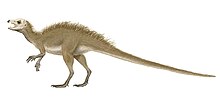Fruitadens
|
Fruitadens Temporal range: Late Jurassic, 150 Ma |
|
|---|---|
 |
|
| Artist's impression | |
| Scientific classification | |
| Kingdom: | Animalia |
| Phylum: | Chordata |
| Class: | Reptilia |
| Clade: | Dinosauria |
| Order: | †Ornithischia |
| Family: | †Heterodontosauridae |
| Genus: |
†Fruitadens Butler et al., 2010 |
| Species | |
Fruitadens is a genus of heterodontosaurid dinosaur. The name means "Fruita tooth", in reference to Fruita, Colorado (USA), where its fossils were first found. It is known from partial skulls and skeletons from at least four individuals of differing biological ages, found in Tithonian (Late Jurassic) rocks of the Morrison Formation in Colorado. Fruitadens is the smallest known ornithischian dinosaur, with young adults estimated at 65 to 75 cm (26 to 30 in) in length and 0.5 to 0.75 kg (1.1 to 1.7 lb) in weight. It is interpreted as an omnivore and represents one of the latest-surviving heterodontosaurids.
Fruitadens is known from fossils recovered under a valid paleontological permit in the 1970s and 1980s by teams led by George Callison, for the Natural History Museum of Los Angeles County (LACM). The discovery area, on lands managed by the Bureau of Land Management, is known as the Fruita Paleontological Area; the specimens were found there in sandstones of the Brushy Basin Member. Roughly equivalent beds have been dated to 150.3 ± 0.3 million years old and 150.2 ± 0.5 million years old, indicating an early Tithonian age.
The fossils now named Fruitadens were first thought to belong to a fabrosaurid similar to Echinodon, a genus from the Early Cretaceous of England; Fabrosauridae at the time was considered a general group of primitive ornithopods, and Echinodon itself had not yet been reclassified as a heterodontosaurid. Fruitadens, although not formally described for a number of years, was briefly described in several works, usually as a relative of Echinodon or a new species of the genus. Formal description came in January 2010, by Richard Butler and colleagues (though the paper was published online before print in late 2009). The type species is F. haagarorum, in recognition of support provided by Paul Haaga Jr., Heather Haaga, Blythe Haaga, Paul Haaga III, and Catalina Haaga for the Natural History Museum of Los Angeles County.
...
Wikipedia
